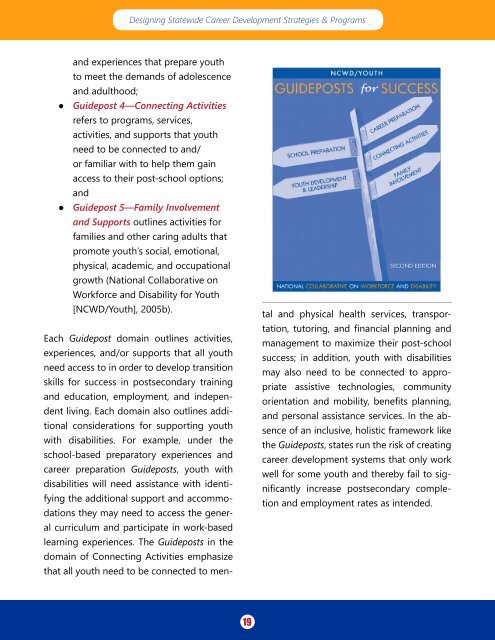Designing Statewide Strategies & Programs
DesigningStatewideCareerDevelopmentStrategiesProgramsPub_0
DesigningStatewideCareerDevelopmentStrategiesProgramsPub_0
Create successful ePaper yourself
Turn your PDF publications into a flip-book with our unique Google optimized e-Paper software.
<strong>Designing</strong> <strong>Statewide</strong> Career Development <strong>Strategies</strong> & <strong>Programs</strong><br />
●●<br />
●●<br />
and experiences that prepare youth<br />
to meet the demands of adolescence<br />
and adulthood;<br />
Guidepost 4—Connecting Activities<br />
refers to programs, services,<br />
activities, and supports that youth<br />
need to be connected to and/<br />
or familiar with to help them gain<br />
access to their post-school options;<br />
and<br />
Guidepost 5—Family Involvement<br />
and Supports outlines activities for<br />
families and other caring adults that<br />
promote youth’s social, emotional,<br />
physical, academic, and occupational<br />
growth (National Collaborative on<br />
Workforce and Disability for Youth<br />
[NCWD/Youth], 2005b).<br />
Each Guidepost domain outlines activities,<br />
experiences, and/or supports that all youth<br />
need access to in order to develop transition<br />
skills for success in postsecondary training<br />
and education, employment, and independent<br />
living. Each domain also outlines additional<br />
considerations for supporting youth<br />
with disabilities. For example, under the<br />
school-based preparatory experiences and<br />
career preparation Guideposts, youth with<br />
disabilities will need assistance with identifying<br />
the additional support and accommodations<br />
they may need to access the general<br />
curriculum and participate in work-based<br />
learning experiences. The Guideposts in the<br />
domain of Connecting Activities emphasize<br />
that all youth need to be connected to mental<br />
and physical health services, transportation,<br />
tutoring, and financial planning and<br />
management to maximize their post-school<br />
success; in addition, youth with disabilities<br />
may also need to be connected to appropriate<br />
assistive technologies, community<br />
orientation and mobility, benefits planning,<br />
and personal assistance services. In the absence<br />
of an inclusive, holistic framework like<br />
the Guideposts, states run the risk of creating<br />
career development systems that only work<br />
well for some youth and thereby fail to significantly<br />
increase postsecondary completion<br />
and employment rates as intended.<br />
19


